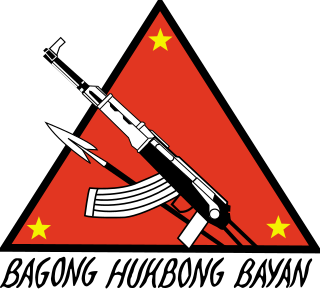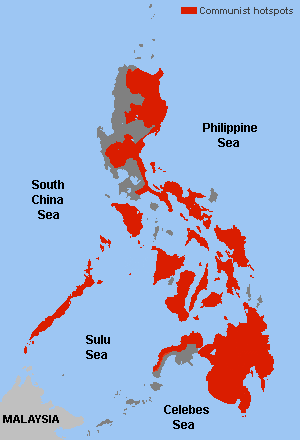
Davao City, officially the City of Davao, is a highly urbanized city in the Davao Region, Philippines. The city has a total land area of 2,443.61 km2 (943.48 sq mi), making it the largest city in the Philippines in terms of land area. It is the third-most populous city in the Philippines after Quezon City and Manila, and the most populous in Mindanao. According to the 2020 census, it has a population of 1,776,949 people.

The New People's Army, abbreviated NPA or BHB, is the armed wing of the Communist Party of the Philippines (CPP). It acts as the CPP's principal organization, aiming to consolidate political power from what it sees as the present "bourgeois reactionary puppet government" and to aid in the "people's democratic revolution". Founded on March 29, 1969, by the collaboration of Jose Maria Sison and former members of the Hukbalahap led by Bernabe Buscayno, the NPA has since waged a guerrilla war based on the Maoist strategy of protracted people's war. The NPA is one of the key figures in the ongoing Communist rebellion in the Philippines, the longest ongoing conflict in the country.

The Communist Party of the Philippines (CPP) is a far-left, Marxist–Leninist–Maoist revolutionary organization and communist party in the Philippines, formed by Jose Maria Sison on 26 December 1968. It is designated as a terrorist group by the United States Department of State together with Sison and its armed wing New People's Army (NPA) in 2002. The European Union renewed its terrorist designation on the organization in 2019, though a 2009 ruling by the EU's second highest court delisted Sison as a "person supporting terrorism" and reversed a decision by member governments to freeze assets. According to the US' Central Intelligence Agency (CIA) World Factbook, the CPP and the NPA aims to destabilize the Philippines' economy and overthrow the national government.

Rodrigo Roa Duterte, also known as Digong, Rody, and by the initials DU30 and PRRD, is a Filipino lawyer and politician who served as the 16th president of the Philippines from 2016 to 2022. He is the chairperson of PDP–Laban, the ruling political party in the Philippines during his presidency. Duterte is the first president of the Philippines to be from Mindanao, and is the oldest person to assume office, beginning his term at age 71.

The New People's Army rebellion is an ongoing conflict between the government of the Philippines and the New People's Army (NPA), which is the armed wing of the Marxist–Leninist–Maoist Communist Party of the Philippines (CPP). It is the world's longest ongoing communist insurgency, and is the largest, most prominent communist armed conflict in the Philippines, seeing more than 43,000 insurgency-related fatalities between 1969 and 2008. Because the National Democratic Front of the Philippines (NDFP) which is the legal wing of the CPP, is often associated with the conflict, it is often also called the CPP-NPA-NDF conflict, or simply the C/N/N conflict, especially in the context of peace talks with the Philippine government.

Martial law in the Philippines refers to the various historical instances in which the Philippine head of state placed all or part of the country under military control—most prominently during the administration of Ferdinand Marcos, but also during the Philippines' colonial period, during the second world war, and more recently on the island of Mindanao during the administrations of Gloria Macapagal Arroyo and Rodrigo Duterte. The alternative term "martial law era" as applied to the Philippines is typically used to describe the Marcos martial law period specifically.
The Citizen Armed Force Geographical Unit, variously called Citizens Armed Forces Geographical Unit, Civilian Armed Forces Geographical Unit and commonly referred to by its acronym CAFGU is an irregular auxiliary force of the Armed Forces of the Philippines focusing on anti-insurgency efforts in the countryside. As of 2022, an estimated 69,938 CAFGU troopers are active in the country, taking part in military operations alongside regular soldiers of the AFP.

The history of communist armed conflicts in the Philippines is closely related to the history of Communism in the Philippines, with various armed conflict linked to the armed wings of the various communist organizations that have evolved since 1930. The two largest conflicts have been the Hukbalahap Rebellion of 1942–1954, and the ongoing rebellion of the New People's Army, which began in 1969 under the auspices of the Communist Party of the Philippines (CPP). But various splinter groups have since separated from the CPP and have had a history of armed conflict with the Philippine government since then.
The following is the timeline of events of CPP-NPA-NDF rebellion, a conflict between the government of the Philippines, the Communist Party of the Philippines (CPP), the New People's Army (NPA) and the National Democratic Front (NDF).
The Integrated Civilian Home Defense Forces, also called the Civilian Home Defense Force and commonly referred to by its acronym CHDF, was an irregular paramilitary force supervised and deployed by the heads of the local government in the Philippines — provincial governors, city and municipal mayors. The CHDF was active during the 1970s, and was officially disbanded in 1986 after the People Power Revolution. However, the creation of the Citizen Armed Force Geographical Unit in 1987 provided the opportunity for CHDF members to once again perform their former duties.

Delfin Negrillo Lorenzana, OLH, KGOR is a retired Philippine Army general who currently serves as the Chairman of the Bases Conversion and Development Authority since 2022. He previously served as Secretary of National Defense in the Cabinet of President Rodrigo Duterte from 2016 to 2022. He served in the Philippine Army from 1973 to 2004.

Proclamation No. 216 was the 2017 proclamation of martial law and suspension of the privilege of the writ of habeas corpus in the whole of Mindanao amid clashes between government forces and Maute group terrorists in Marawi, issued by Philippine President Rodrigo Duterte on May 23, 2017. The state of martial law was extended thrice by Congress at the request of Duterte, citing necessity to quell hostile activities perpetrated by terrorist groups, and ended with the third extension lapsing on December 31, 2019.

At 7:15 p.m. on September 23, 1972, President Ferdinand Marcos announced on television that he had placed the Philippines under martial law, stating he had done so in response to the "communist threat" posed by the newly founded Communist Party of the Philippines (CPP), and the sectarian "rebellion" of the Muslim Independence Movement (MIM). Opposition figures of the time accused Marcos of exaggerating these threats and using them as an excuse to consolidate power and extend his tenure beyond the two presidential terms allowed by the 1935 constitution. Marcos' signed Proclamation No. 1081 on September 21, 1972, marking the beginning of a fourteen-year period of one-man rule which effectively lasted until Marcos was exiled from the country on February 25, 1986. Proclamation No. 1081 was formally lifted on January 17, 1981, although Marcos retained essentially all of his powers as dictator until he was ousted in February 1986.
The dictatorship of Philippine President Ferdinand E. Marcos in the 1970s and 1980s is historically remembered for its record of human rights abuses, particularly targeting political opponents, student activists, journalists, religious workers, farmers, and others who fought against the Marcos dictatorship. Based on the documentation of Amnesty International, Task Force Detainees of the Philippines, and similar human rights monitoring entities, historians believe that the Marcos dictatorship was marked by 3,257 known extrajudicial killings, 35,000 documented tortures, 737 'disappeared', and 70,000 incarcerations.

Eduardo "Ed" Drueco del Rosario is a Philippine Army veteran and government official who served as the first Secretary of Human Settlements and Urban Development of the Philippines under the Duterte administration, from January 2, 2020 to June 30, 2022. He previously served as Chairperson of the now-defunct Housing and Urban Development Coordinating Council which was abolished and replaced by the Department of Human Settlements and Urban Development created through Republic Act No. 11201 on February 14, 2019. Del Rosario served 37 years in the Armed Forces of the Philippines, retiring as a major general in 2012. His service included tours as commander of the AFP Southern Luzon Command and of the 2nd Infantry Division.

The National Task Force to End Local Communist Armed Conflict (NTF-ELCAC) is a task force organized by the government of the Philippines in 2018 as part of its "Whole-of-Nation approach" to respond to and raise awareness about ongoing communist armed conflicts in the Philippines, after the administration of President Rodrigo Duterte formally terminated peace talks between the Philippine government and the New People's Army in November 2017.

Antonio Gumba Parlade Jr. is a former Filipino military officer who retired as commander of the Armed Forces of the Philippines Southern Luzon Command in 2021, and was best known for his combative terms as spokesman for the Philippine Army before he was removed from that post in 2011, and later, as spokesperson of the National Task Force to End Local Communist Armed Conflict (NTF-ELCAC).
The Military history of the Philippines during the presidency of Ferdinand Marcos, especially the 14-year period between Marcos' proclamation of Martial Law in September 1972 and his final ouster through the People Power Revolution of 1986, was characterized by rapid changes linked to Marcos' use of the military as his "martial law implementor."
Historians estimate that there were about 70,000 individuals incarcerated by the authoritarian regime of Ferdinand Marcos in the period between his 1972 declaration of Martial Law until he was removed from office by the 1986 People Power Revolution. This included students, opposition politicians, journalists, academics, and religious workers, aside from known activists. Those who were captured were referred to as "political detainees," rather than "political prisoners," with the technical definitions of the former being vague enough that the Marcos administration could continue to hold them in detention without having to be charged.












